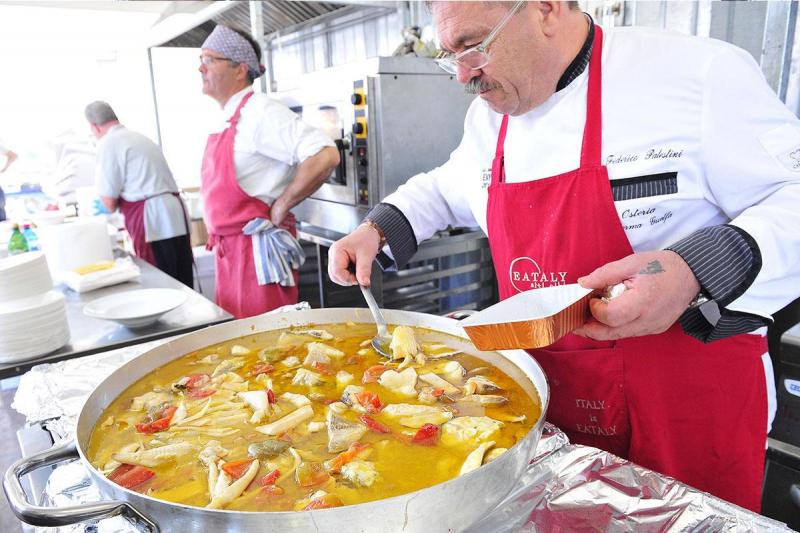For most Italian citizens autumn means the end of the holiday season and the moment to get back to work. But for Italian farmers – contadini –autumn marks the time to reap the fruits of their labor and celebrate. Sagra is a perfect occasion for that.
The word “Sagra” derives from the latin “sacrum”, which, initially, in ancient times, was a community feast to thank the gods for the abundance of the harvest. Later, with the spread of Christianity, Sagra became the feast day of a patron saint of a town, whose celebration often included solemn processions in the name of the saint and God.
Today, the Italian Sagra has become a kind of food festival dedicated to local delicacies or products. It is the perfect occasion to get together and enjoy the beauty of life itself with all the fruits the land can offer.
Originally, “Sagre” were very local community events, but nowadays some of them have become quite famous all over the country and even in Europe. Each year more and more tourists love visiting “sagre” and taste local food and wine in an informal and joyful atmosphere.
“Sagre” can be held all year round, but most of these food-related events occur in spring and in autumn. For example, Piedmont can boast the “Fiera del Tartufo” in Alba or the “Sagra del Peperone di Carmagnola” near Turin and a lot of smaller events that take place from the beginning of September till the beginning of winter. But if you opt for a smaller local sagra, don’t expect to find English translations everywhere you go.

In this article, we’re giving you the necessary vocabulary to make you enjoy your visit to an Italian sagra and make the best of this experience.
As already mentioned, sagre can be dedicated to different food and products of the earth, and the options are numerous. Those held in autumn are naturally related to typical seasonal products like:
- la castagna – chestnut
“La sagra della Castagna” is a long-awaited event all over the country. You can visit one in Lazio, in Tuscany and in many other regions, where you’ll have a chance to try delicious “Marron glaces” (chestnuts candied in sugar syrup) or a typical Tuscan chestnut flour cake “Castagnaccio”.
- la zucca – pumpkin
At a “Sagra della zucca” you’ll find pumpkins of all shapes and colors and will probably be able to taste a “risotto alla zucca” or other typical dishes of the territory.
- il porcino – a type of white mushrooms
There can be sagre dedicated only to this mushroom loved by many Italians, to mushrooms – funghi – as a whole.
“La sagra dei funghi” is a pefect place for someone who likes to try these fragrant delicacies in a risotto or with pasta.
- il tartufo – truffle
Last but not least is the long-awaited “Sagra dei tartufi”, which is probably the most visited one. Here you can taste exquisite dishes with this rare and unique ingredient (like the piedmontese tajarin al tartufo d’Alba) or buy a black truffle – tartufo nero or even a white one – tartufo bianco.
Note that the most popular food events and sagre host a huge number of people daily, so make sure to arrive in advance. Here’s a small list of fruit and vegetables – frutta e verdura, and other ingredients a sagra can be dedicated to:
- la nocciola – hazelnut
- Il peperone – bell pepper
- il miele – honey
- la patata – potato
- il peperoncino – hot pepper
- il formaggio – cheese
- la pera – pear
- la mela – apple
As you can see, the list can go on. Numerous sagre are linked to the vendemmia – grape harvest.
The best way not to miss a sagra is to look for posters promoting the event while wandering around an Italian town, or to ask directly at the local tourist office – Ufficio del turismo. A typical sagra is usually held on the main piazza (square) of the town or is spread over the streets near the main piazza. Sometimes it can also happen in a field – il campo. Each sagra has a small market – il mercatino with some stands – i banchi (sing. il banco), where you can purchase local delicacies, wine and spirits at their lowest price, if you’re lucky enough and, of course, speak Italian. You can ask the farmer:
“Quanto costa/viene un chilo di castagne?” – How much does 1 kg of chestnuts cost? (of course you can insert any product you like)
Or
“Cosa mi consiglia?” – What would you recommend?
Before buying something, you can ask to try something:
“Posso assaggiare?” – Can I try?
The more you purchase, the more discount you’ll get:
“Mi fa uno sconto?” – Would you give me a discount?
Farmers are usually quite good at cooking simple but tasty dishes with the ingredients they have for sale and know how to pair them, so don’t hesitate to ask for a recipe:
“Come lo (la, le, li) posso cucinare?” – How can I cook it (them)?
Or
“Mi suggerisce qualche ricetta?” – Would you suggest me a recipe?
A short guide to decipher the answer:
- in padella con un filo d’olio – on a pan with a dash of oil
- bollito – boiled
-al forno – baked in the oven
- crudo – raw
- al vapore – steamed
Aside from the food stands, there probably will be a sort of a flea market – il mercatino delle pulci, where you can find anything from the simple trinkets to the vintage furniture in a decent condition and rare prodotti artigianali - handicrafts.
But let’s talk about the real purpose of your visit: il cibo (food).

At a sagra you will see crowds of people sitting together at long tavoli comuni (communal tables) on le panche (benches). Sometimes they are placed under a special tendone (marquee tent), sometimes –in the middle of a square under an open sky. There always will be a special place where the organizers prepare food – la cucina. Often, there are separate tents for different dishes. In one you can order a plate of pasta, in another one you can ask for grilled meat. And, of course, there are lines to stand in (fare la coda). You’ll have to fare la coda at least twice: the first one to place an order and take a ticket – il bigliettino or lo scontrino – with your number, the other one is to get your dish with it. If you didn’t find a place to eat at by this moment, it’s time to do it. Since at a sagra unfamiliar people can sit next to each other at a common table, don’t forget to ask if the seat is still fee:
“Scusi, questo posto è libero?”
Note that most of the time you shouldn’t expect a real coperto (cover charge) with plates and utensils, so you will have to settle for plastic plate and cutlery.
The other essential part of any sagra is i balli – dancing. Most surely you will see a lot of elderly Italians dancing passionately at the music played by a local banda musicale – musical band. Bigger events, like sagre linked to some particular holiday, may have rievocazioni storiche (historical reenactments) as a part of the program.
Remember, that most of the time, a Sagra is just a local event dedicated entirely to food and to the moments of joy and happiness in a company of people you’ve been knowing for ages and people you’re about to get to know there if you’re not afraid to speak Italian. A sagra is the right place for you if you want to taste true locally sourced dishes and witness the real Italia. Stay with us to get to know better the Italian language and customs.










